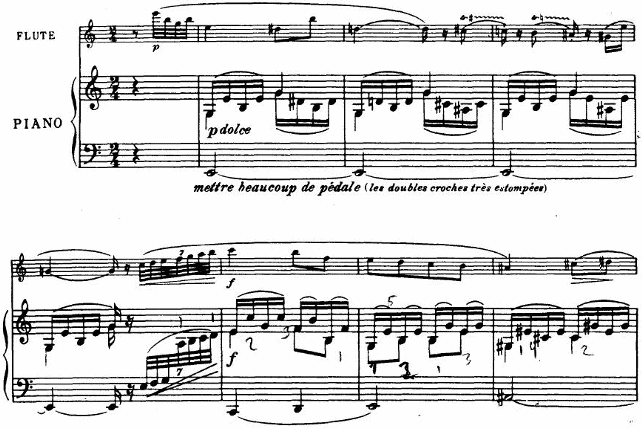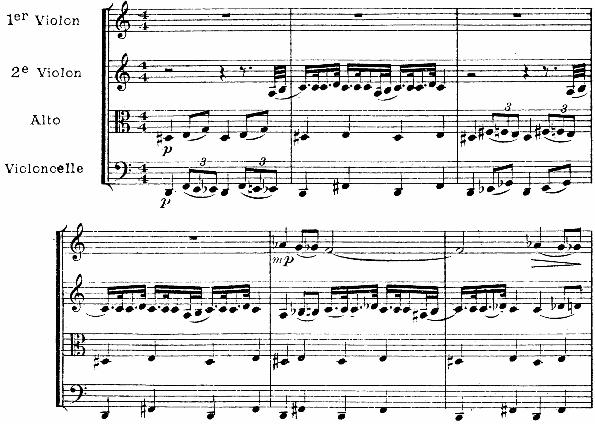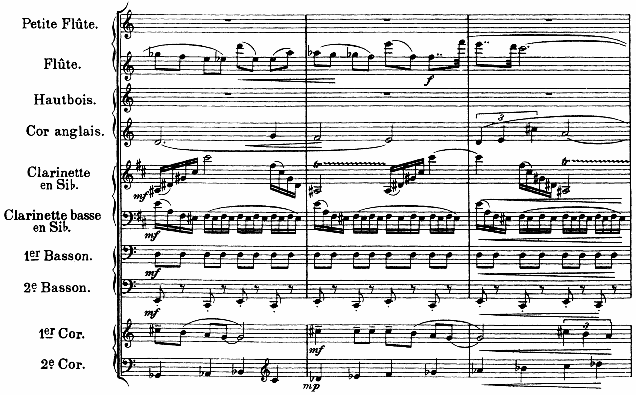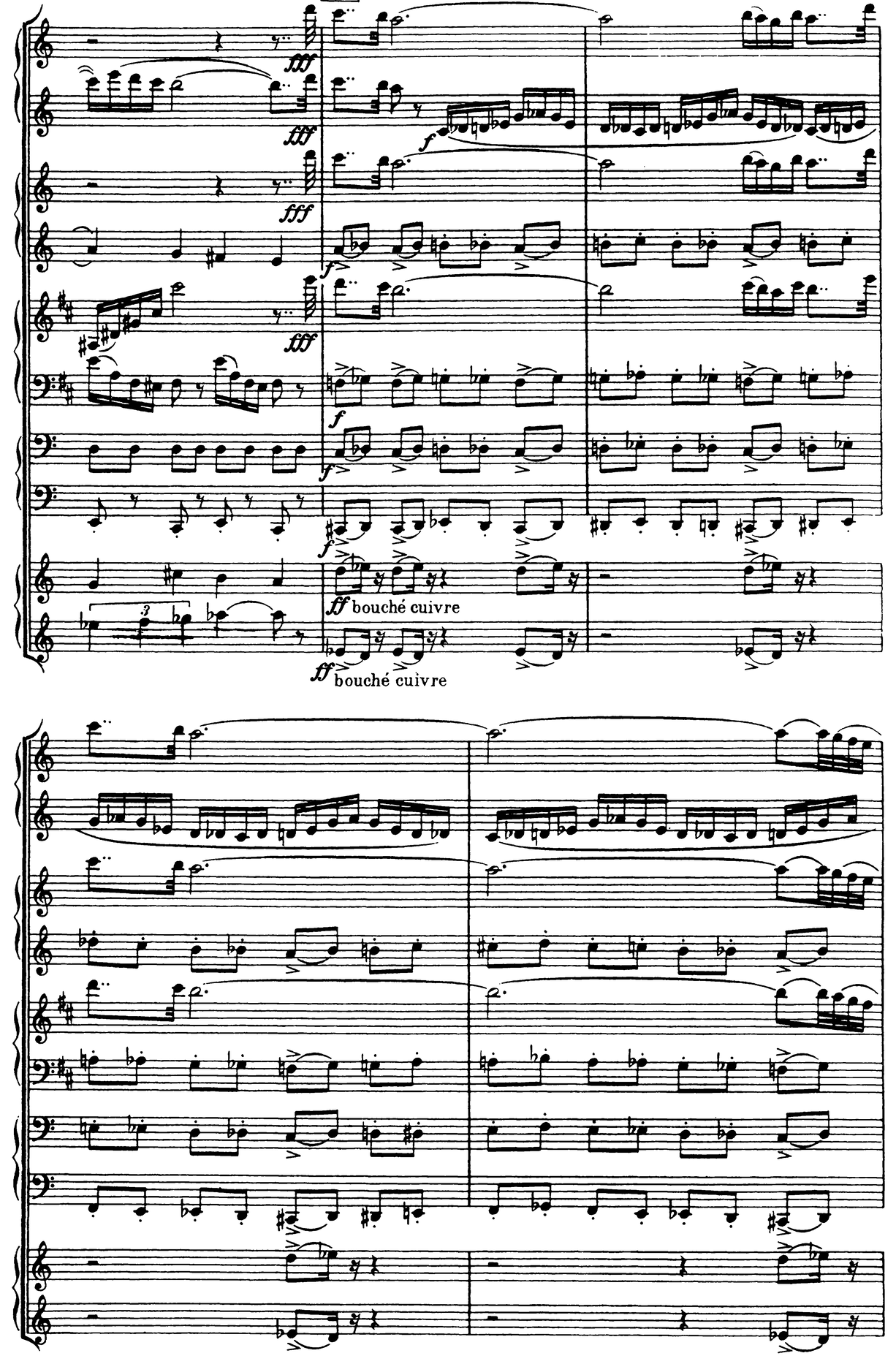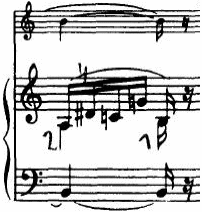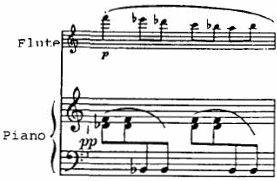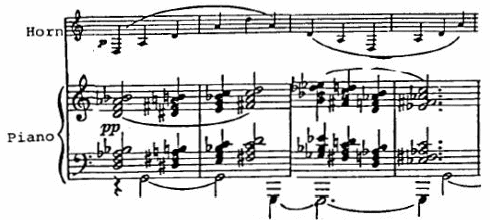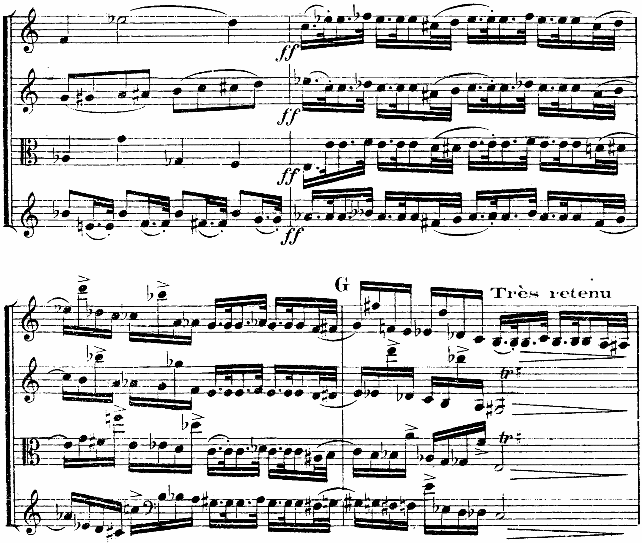CHAPTER 3
-
Reflection of Aesthetic in the compositions
Having identified the principal elements of a shared aesthetic, is it possible to begin to identify which compositional aspect reflects them.
The most popular techniques of the Parisian compositional style of the 1920s can be found throughout this music.
The composers experimented in the early years with boundaries of tonality - a field which had already been explored by other composers of the time.
Despite later rejecting much of Debussy's style, initially these composers were influenced by him and in some cases continued in this manner in later works. Aspect include the use of parallel chord-streams or dyads and of exotic scales. For example, the opening bars of the Poulenc's Sonata for two Clarinets (mm.1-14) are completely based on the pentatonic scale. Two pentatonic scales, built a tritone apart, are presented simultaneously by the two clarinets, with vertically resulting thirds and tritones.
mm.3-4
With regards to parallel triads, sevenths and ninth chords appear frequently in the early works of Poulenc and Milhaud. In Poulenc's Elégie (mm.156-163) we find various types of seventh chords over a dominant pedal. This technique serves a unifying role for the vertical elements, as found in both the third movement of the Oboe Sonata (mm. 27-36), where major sevenths in free relation are combined with a tonic pedal, and the first movement of the Sextour (mm.47-52), which has parallel minor sevenths.
Elégie mm.156-159
Beside to these techniques, the composers experimented also modus from contemporary composers such as Stravinsky and Schoenberg. Serialism certainly inspired Poulenc in his use of ostinato and atonal pitch segments.1 Both I (mm.108-111) and II (mm.90-92) movements of the Sextour present a statement of a series of non-recurring pitch classes in free relation, 8 notes the first, 9 and 7 the second. In each instance, the sense of tonic previously established is destroyed by a passage of free related pitches, followed by a return to the tonic or to a new tonic altogether.
Sextour, I: mm.108-111
Also the recapitulation of the main material (mm. 25-38) is controlled by a similar mechanism: a chromatic ostinato (English horn, bass clarinet and bassoons) of gradually increasing length, whose length increases from one to nine crotchet beats. Against this fixed mechanical elements, the concertino (piccolo, oboe, clarinet and first half bar for the flute) presents the main thematic material.
Chamber Symphony n.5, III: mm.24-28
Different meters are used concurrently in order to unsettle the established rhythm. Auric, in the Final of his Oboe/Clarinet/Bassoon Trio (mm.35-36), change the meter in the oboe line from a 9/8 to a 3/4, almost jamming the hitherto predominant ternary character with the clarinet's joining of 3/4 meter in the last bar.
The influence of Popular stylistic traits is reflected in the unordinary uses of rhythm.
The use of popular idioms by this composers should not be seen as mere copy, but as a portrait of music-hall, bal-musettes and circus' styles.6 In order to recreate the jangling simultaneity that one could find in the Parisian fairground and music-hall, they utilized bi and poly-tonality, striking fluctuation in tempo and meter, juxtapositions of different musical material, such as short tuneful ideas distinguished by tonality, rhythm and tempo. It's typical for Auric to settle a steady tempo and clear beat in the opening bars of the piece, almost to lower the listener's expectations. Then, after one or more phrases, he starts introducing shifts in tempo and meters, giving a sensation of speech-like fluidity. In some of his pieces, this variations and changes appear so often that the imitation of music-hall style becomes almost a caricature of it (example in the first 13 bars of his 'Place des Invalides').
The attention to Popular music finds its roots in the childhood and early experiences of the composers, and, encouraged by figures such as Satie and Cocteau, was consolidated by the experience of the Saturday night meetings. Crucial was the idea of simplicity and refinement found in Satie and Cocteau; these elements were pivotal in creating simple melodies without losing the popular flavor that both desired.
Popular music and “art” music are seen as two faces of the same coin, and are often associated with classical and baroque style.7
Together with music-hall, popular ballad and circus music influences appear frequently.
Popular ballad traits often appear in the B section of Poulenc's music. These pieces are characterized by the use of a mostly classical phrasing (usually 4 measures), with a melody that presents various appoggiaturas and accented dissonances. A good example can be found in the 1st movement of the Poulenc's Trio for Piano, Oboe and Bassoon, mm.160-176Video.
In the popular ballad inspired sections, the harmony moves in a slow harmonic rhythm, and is based on higher tertian structures in fifth relation. It generates constant modulation and lack of centered tonality, and is quite similar to the incessant 'down by step' modulation which is ubiquitous in American popular songs ('All the Things You Are'Audio or 'How High the Moon'Audio). Due to these higher tertian structures, the texture becomes rather dense - a slow syncopated accompaniment played in chordal blocks, with the presence of after-beat chord arrangement at the bass. In the first movement of the Sonata for Oboe (mm.22-25) this can be seen along with an alternation (“call and answer”) between the voices.
Oboe Sonata, I: mm-22-25
Texture and instrumentation show great affinity with the Neoclassical style. In late eighteenth-century chamber music for keyboard and other instruments, the fortepiano or harpsichord would often open the movement with a solo. Themes would then be doubled by the other instruments in thirds, sixths and octaves.19Texture is characterized by large use of homophonic patterns of the classical period. In the Flute Sonata we find uses of Murky bass in the second movement (m.3) and of Albertini bass in the third movement (mm.39-41). The second movement of Sextour (m.1) starts with an example of drum bass, and includes frequent chordal arpeggiations in eighth or sixteenth-note triplets or quadruplets.
Flute Sonata, II: m.3

Strictly connected with the chord's parallelism is the use of chromaticism and chromatic motion. For Milhaud chromaticism was an important element in his works before 1922. He exploits it in his first experimentation on dissonance, which lead him to poly-tonality. Linearly, chromaticism appear as a series of non-diatonic pitches in relation to a strong diatonic collection, or as Blues thirds or sevenths (an element that already reflects influences of blues, jazz and ragtime). On the surface, chromaticism creates a dissonant contrary motion which can be found in 2, 3, 4 or 6 parts. For example, in the first bars of the Funèbre, from Milhaud's Fourth Quartet, the diatonicism of the A theme of violin II is in contrast with the chromatic lines of viola and cello. At bar 5, the entrance of violin I bridge the upper and lower segments. The resulting fragment of violin II mixes the dotted figure of motive A with the chromatic character of motive B. This leads to the climax of the movement in bars 65-67, where the union of A and B motive reappears, heightened by the sudden rhythmic unison and the fortissimo dynamic.
Quartet n.4, II: mm.1-6
One of the results in combining these two techniques is static melodies. Static melodies are usually built from pan-diatonic cells of narrow range, and tend to be almost a 'play' on a small collection of pitches, with frequent returns to one specific pitch. It rarely shows non-tonal tendencies. An example of static melodies is the bassoon partVideo of the Poulenc's Trio for Piano Oboe and Bassoon (1st movement, mm62-64)
Poly-tonality, chromatism, limited pitch series and fixed ostinati were used by Milhaud to emphasize the 'machine aesthetic'.2 The preoccupation with the machine is one of the predominant features of his early exploration. 'Distancing techniques' and the 'depersonalisation' are inherent in the idea of mechanization, and are often achieved musically by means of conflicting, fixed ostinati.3
The machine aesthetic provided points of connection with modernism (Futurism and the Bauhaus group)4, and lead the composer to link this idea of mechanization with jazz.5 Examples of ostinato and chromatic ostinato can be found in the finale 'Violent' of the Chamber Symphony N.5. In the B section (mm.17-24) we can see the use of a ostinato ripieno in the bass clarinet and bassoons I and II, with the addition of the clarinet in the last four bars.
Chamber Symphony n.5, III: mm.21-23
A final example of the experimental trait is the exploration in rhythmic possibilities. Changing meters, isorhythm and poly-meter are used to create irregular and fluctuating phrase lengths.
In the first movement of the Clarinet/Bassoon Duo (mm.1-5), the bassoon part creates an underlining poly-metric pattern of 5,4,5 and 3 crotchets, while the clarinet part forms a parallel period, in which the second phrase is shortened by one quarter note, due to the change of the meter (structurally: 3/4-3/4-3/4-5/4-3/4).
Clarinet and Bassoon Duo, I: mm.1-5
The circus-influenced music is characterized by its simplicity. Simple triadic melodies are usually set against an uncomplicated triad-based harmony. Furthermore, the rhythmic patterns do not stray from the global idea of simplicity. 'Wrong notes' appear often, which create dissonance and a sort of “musical joke”. They refer to the inaccuracy of circus musicians of the time. In the third movement of the Sonata for Horn, Trumpet and Trombone (mm. 1-4, 54-56) the theme that appears in the opening bars is represented afterwards slightly altered, with more dissonances and chromaticism.
Horn, Trumpet and Trombone Sonata, III: mm.1-4
Mockery and parody appear in works from all the composers, and this is strictly linked with the circus environment.8 The use of repeated two/three-notes figures without giving them a clear function (such as introduction, transition, ostinato or conclusion), creates the sense of deliberate spoof on the perpetual variations, shifting harmonies, complexity and seriousness of nineteen-century music. Examples of this practice can be found in Les Mariés de la Tour Eiffel. Milhaud in his 'Marche nuptiale', uses an over-sentimental violin solo containing wide jumps that reach the peak of the instrument's range as a counterpart to the cliché expressions used to introduce the characters.9 At the end of the march, Milhaud extends the cadential structure with the reiteration of a pattern of fortissimo C major chords in the strings and brass through to the melodramatic end of the piece. This mocks not only ceremonial pomp, but also the eighteenth- and nineteen-century techniques of prolonged cadences.
In 'Discours du Général' Poulenc's parody starts with the use of a Polka tempo, instead of a more appropriate march style. The General's speech is mocked by the cornet theme which repeats once or twice each pitch before moving on to the next. This theme is punctuated by snare drum rolls and presents responses to the cornet lines in the form of swaggering trombone glissandos.
The instrumentation by Auric in the 'Overture', reminiscent of those of brass and military band, is clearly in contrast with the grace one would expect in a wedding procession. Thuds in the tuba, timpani and double bass punctuate a heaving march, and a series of countermelodies in different keys superimposed to a sturdy brass fanfare recall the sounds of the fairground.
The choice of instrumentation also reflects other influences, such as jazz and blues.
In La Création du monde Milhaud duplicated Maceo Pinkard's scoring of Liza: flute, clarinet, trumpet, trombone, piano, percussion, string quartet with the viola replaced by a tenor saxophone, and double bass. His only change was the addition of oboe, bassoon and horn.10
Influences by Jazz and Blues are peculiar in Milhaud music. Poulenc states several times that he wasn't interested in it, preferring rather music that he felt more truly French.11 Auric, after his last jazz-inspired compositions Adieu, New-York! in 1919, declared in his article Bonjour, Paris! that jazz had served its purpose, and it was now time for composers to turn to French musical sources.12
This piece brought together the many different American popular styles encountered by the composer, such as foxtrots, rags, ragtime and Tin Pan Alley songs. The typical dotted rhythm is used together with the formal device of successive sections or strains. A repeated two bar figure, that introduce the first strain, reminds us of vamps in American popular songs and dances.
Typical of the jazz-inspired style is the use of 'blue notes' (lowered thirds or sevenths), Blues harmony, melody, and rhythmical variations. These jazz influences are exemplified in La Création du monde: in the Fugue (mm.1-11) we can find alternations between F (blue note) and F# (major third), and the lowered seventh and a lowered third in the context of a chromatic ascent. The same passage shows a five-note idea which duplicates the opening figure of the famous jazz theme St. Louis BluesAudio.13 In the second movement (mm.1-7) we find elements typical of blues progression, particularly the movement between the tonic and the subdominant chords. Here we can find the alternation between a C major and F major chord, with the Eb that has the double function of a lowered third for C and lowered seventh for F. The third movement shows the use of the so-called 'secondary ragtime'. It consist of the layering of a new rhythmic pattern upon the prevailing rhythm of the music. Here Milhaud placed a three eight notes pattern upon the normal four-quarter rhythm of jazz.
Rhythmical patterns borrowed from Brazilian music are present in Le Boeuf sur le toit, where mannerist rhythmic ideas typical of Brazilian dances are united with the use of typical instruments.14
Neoclassical traits are another important aspect of the composers' works. They often refer to baroque and classical composers as examples for their compositions. Couperin appears to have a strong influence on them, as we can see in Milhaud's orchestral arrangement Introduction et Allegro from Couperin's Suite La Sultane, and from the several statements of Poulenc on this subject.15
Classical structures and proportions, stylistic refinement, brevity and simplicity, are all included in the works of the composers. However, this never leads to a mere copy: these elements are reshaped by them in a sort of homage to French tradition and baroque music.
Milhaud's Six Chamber Symphonies were surely inspired by the Bach's Six Brandenburg Concerti. The French composer was 'attracted by the unusual quality of small groups of instruments'.16Le Printemps, from the First Chamber Symphony, has a clear association with Vivaldi, and there are references to Monteverdi about the brevity of the piece.17 The vast assortment of styles used by Auric is a recall to the seventeenth-century Fantasia, and the Poluenc's study for over three years of Bach's chorale melodies settle a clear connection with the baroque atmosphere.
Typical Neoclassical elements are diatonic, often stepwise, melodies, with clear triadic basis and motivic derivations. The introduction of non-diatonic tones (seemingly 'wrong-notes') often creates humorous results.
The harmony is mostly in accordance with Bach's practice, with emphasis of tonic pedals and tonic/dominant relationship. Nevertheless, these elements are no more than a reference, or starting point, and are often mixed with frequent changes of mode, rapid modulation and chromatism.
In the Allegro malinconico18 from the Flute Sonata (mm.1-8), an eight measures theme in E minor descends chromaticly from E to G, supported harmonically by a tonic pedal, is then followed by a sudden shift in tonal center to C major, with a return to E minor through the V13 of the latter key.
The metrical positions of the rhythms rarely resemble classical patterns. Mixed meters are used to upset the phrase symmetry and balance. Often a periodicity of phrasing is initially established, and then suddenly an extra measure, beat or part of a beat is inserted, creating surprise and destabilising the rhythm. Changes to meter of a shortened duration are often structurally significant as they occur at important cadence points.
In the first movement of Pulenc's Oboe Sonata, generally in 3/4-4/4, a 2/4 measure appears at the most important cadences and structural divisions (mm.14,43,47 and 71), contributing to the harmonically-open nature of the movement.
1 - In 1921 he traveled with Milhaud to Vienna, where he met Schoenberg and Berg and studied their music. He stated about Schoenberg's works 'Of course, there was never a question of subjecting myself to Schoenbergian doctrines . . . I was curious about music which is the more removed from me . . .', from Moi et mes amis, p. 22.
5 - See Milhaud's essay 'Les ressources nouvelles de la musique (jazz-band et instruments mécaniques)', from L'Espirit nouveau, 1924.
6 - Francis Poulenc, Le Coq 1/2, June 1920. 'Auric's Fox-Trot is not a copy of a Fox-Trot. It is the portrait of a Fox-Trot. It is not to be danced to, it is to be listened to. One can criticize it from a photographic point of view, but as a portrait it is a perfect work. It should serve as an example to all musicians who are satisfied to parody a modern dance.'
7 - Francis Pulenc, Moi et mes amis, p.34. 'From childhood onwards I have associated the bal musette with the Couperin Suites in a common love, without distinguishing between them.'
9 - 'The bride, sweet as a lamb', 'The bridegroom, handsome as a metinée idol', 'The General, dumb as a goose'.
11 - Francis Poulenc, 'Mes maitres et mes amis', Conferencia: Journal de l'Université des annales, 29, p. 524. 'I do not even like [jazz] and I certainly do not want to hear about its influence on contemporary music. It amuses me when I listen to recordings of it while taking my bath, but it is frankly distasteful to me in the concert hall.'
14 - Use of the rhythm of sixteenth-eight-sixteenth typical of Samba, and use of the 'guitcharo' (or guiro) a percussion instrument.
15 - Hell, Poulenc, p. 271-272. 'It is written in the greatest French tradition, from Couperin to Debussy'.
17 - Ibid. about the first performance of the First Chamber Symphony 'The audience did not seem surprised by the sonorities of my music, but, ignorant or forgetful of the fact that in Monteverdi's day the world 'symphony' was sometimes used to denote a single page of music, it was expecting to hear a huge work with a huge orchestra; it was shocked by the brevity of my piece.'
CHAPTER 3
-
Reflection of Aesthetic in the compositions
Having identified the principal elements of a shared aesthetic, is it possible to begin to identify which compositional aspect reflects them.
The most popular techniques of the Parisian compositional style of the 1920s can be found throughout this music.
The composers experimented in the early years with boundaries of tonality - a field which had already been explored by other composers of the time.
Despite later rejecting much of Debussy's style, initially these composers were influenced by him and in some cases continued in this manner in later works. Aspect include the use of parallel chord-streams or dyads and of exotic scales. For example, the opening bars of the Poulenc's Sonata for two Clarinets (mm.1-14) are completely based on the pentatonic scale. Two pentatonic scales, built a tritone apart, are presented simultaneously by the two clarinets, with vertically resulting thirds and tritones.
mm.3-4

With regards to parallel triads, sevenths and ninth chords appear frequently in the early works of Poulenc and Milhaud. In Poulenc's Elégie (mm.156-163) we find various types of seventh chords over a dominant pedal. This technique serves a unifying role for the vertical elements, as found in both the third movement of the Oboe Sonata (mm. 27-36), where major sevenths in free relation are combined with a tonic pedal, and the first movement of the Sextour (mm.47-52), which has parallel minor sevenths.
Elégie mm.156-159

Oboe Sonata mm. 27-36

Strictly connected with the chord's parallelism is the use of chromaticism and chromatic motion. For Milhaud chromaticism was an important element in his works before 1922. He exploits it in his first experimentation on dissonance, which lead him to poly-tonality. Linearly, chromaticism appear as a series of non-diatonic pitches in relation to a strong diatonic collection, or as Blues thirds or sevenths (an element that already reflects influences of blues, jazz and ragtime). On the surface, chromaticism creates a dissonant contrary motion which can be found in 2, 3, 4 or 6 parts. For example, in the first bars of the Funèbre, from Milhaud's Fourth Quartet, the diatonicism of the A theme of violin II is in contrast with the chromatic lines of viola and cello. At bar 5, the entrance of violin I bridge the upper and lower segments. The resulting fragment of violin II mixes the dotted figure of motive A with the chromatic character of motive B. This leads to the climax of the movement in bars 65-67, where the union of A and B motive reappears, heightened by the sudden rhythmic unison and the fortissimo dynamic.
Quartet n.4, II: mm.1-6

Quartet n.4, II: mm.64-67

Beside to these techniques, the composers experimented also modus from contemporary composers such as Stravinsky and Schoenberg. Serialism certainly inspired Poulenc in his use of ostinato and atonal pitch segments.1 Both I (mm.108-111) and II (mm.90-92) movements of the Sextour present a statement of a series of non-recurring pitch classes in free relation, 8 notes the first, 9 and 7 the second. In each instance, the sense of tonic previously established is destroyed by a passage of free related pitches, followed by a return to the tonic or to a new tonic altogether.
Sextour, I: mm.108-111

Sextour, II: mm.90-92

One of the results in combining these two techniques is static melodies. Static melodies are usually built from pan-diatonic cells of narrow range, and tend to be almost a 'play' on a small collection of pitches, with frequent returns to one specific pitch. It rarely shows non-tonal tendencies. An example of static melodies is the bassoon partVideo of the Poulenc's Trio for Piano Oboe and Bassoon (1st movement, mm62-64)
Poly-tonality, chromatism, limited pitch series and fixed ostinati were used by Milhaud to emphasize the 'machine aesthetic'.2 The preoccupation with the machine is one of the predominant features of his early exploration. 'Distancing techniques' and the 'depersonalisation' are inherent in the idea of mechanization, and are often achieved musically by means of conflicting, fixed ostinati.3
The machine aesthetic provided points of connection with modernism (Futurism and the Bauhaus group)4, and lead the composer to link this idea of mechanization with jazz.5 Examples of ostinato and chromatic ostinato can be found in the finale 'Violent' of the Chamber Symphony N.5. In the B section (mm.17-24) we can see the use of a ostinato ripieno in the bass clarinet and bassoons I and II, with the addition of the clarinet in the last four bars.
Chamber Symphony n.5, III: mm.21-23

Also the recapitulation of the main material (mm. 25-38) is controlled by a similar mechanism: a chromatic ostinato (English horn, bass clarinet and bassoons) of gradually increasing length, whose length increases from one to nine crotchet beats. Against this fixed mechanical elements, the concertino (piccolo, oboe, clarinet and first half bar for the flute) presents the main thematic material.
Chamber Symphony n.5, III: mm.24-28

A final example of the experimental trait is the exploration in rhythmic possibilities. Changing meters, isorhythm and poly-meter are used to create irregular and fluctuating phrase lengths.
In the first movement of the Clarinet/Bassoon Duo (mm.1-5), the bassoon part creates an underlining poly-metric pattern of 5,4,5 and 3 crotchets, while the clarinet part forms a parallel period, in which the second phrase is shortened by one quarter note, due to the change of the meter (structurally: 3/4-3/4-3/4-5/4-3/4).
Clarinet and Bassoon Duo, I: mm.1-5


Different meters are used concurrently in order to unsettle the established rhythm. Auric, in the Final of his Oboe/Clarinet/Bassoon Trio (mm.35-36), change the meter in the oboe line from a 9/8 to a 3/4, almost jamming the hitherto predominant ternary character with the clarinet's joining of 3/4 meter in the last bar.
The influence of Popular stylistic traits is reflected in the unordinary uses of rhythm.
The use of popular idioms by this composers should not be seen as mere copy, but as a portrait of music-hall, bal-musettes and circus' styles.6 In order to recreate the jangling simultaneity that one could find in the Parisian fairground and music-hall, they utilized bi and poly-tonality, striking fluctuation in tempo and meter, juxtapositions of different musical material, such as short tuneful ideas distinguished by tonality, rhythm and tempo. It's typical for Auric to settle a steady tempo and clear beat in the opening bars of the piece, almost to lower the listener's expectations. Then, after one or more phrases, he starts introducing shifts in tempo and meters, giving a sensation of speech-like fluidity. In some of his pieces, this variations and changes appear so often that the imitation of music-hall style becomes almost a caricature of it (example in the first 13 bars of his 'Place des Invalides').
The attention to Popular music finds its roots in the childhood and early experiences of the composers, and, encouraged by figures such as Satie and Cocteau, was consolidated by the experience of the Saturday night meetings. Crucial was the idea of simplicity and refinement found in Satie and Cocteau; these elements were pivotal in creating simple melodies without losing the popular flavor that both desired.
Popular music and “art” music are seen as two faces of the same coin, and are often associated with classical and baroque style.7
Together with music-hall, popular ballad and circus music influences appear frequently.
Popular ballad traits often appear in the B section of Poulenc's music. These pieces are characterized by the use of a mostly classical phrasing (usually 4 measures), with a melody that presents various appoggiaturas and accented dissonances. A good example can be found in the 1st movement of the Poulenc's Trio for Piano, Oboe and Bassoon, mm.160-176Video.
In the popular ballad inspired sections, the harmony moves in a slow harmonic rhythm, and is based on higher tertian structures in fifth relation. It generates constant modulation and lack of centered tonality, and is quite similar to the incessant 'down by step' modulation which is ubiquitous in American popular songs ('All the Things You Are'Audio or 'How High the Moon'Audio). Due to these higher tertian structures, the texture becomes rather dense - a slow syncopated accompaniment played in chordal blocks, with the presence of after-beat chord arrangement at the bass. In the first movement of the Sonata for Oboe (mm.22-25) this can be seen along with an alternation (“call and answer”) between the voices.
Oboe Sonata, I: mm-22-25

The circus-influenced music is characterized by its simplicity. Simple triadic melodies are usually set against an uncomplicated triad-based harmony. Furthermore, the rhythmic patterns do not stray from the global idea of simplicity. 'Wrong notes' appear often, which create dissonance and a sort of “musical joke”. They refer to the inaccuracy of circus musicians of the time. In the third movement of the Sonata for Horn, Trumpet and Trombone (mm. 1-4, 54-56) the theme that appears in the opening bars is represented afterwards slightly altered, with more dissonances and chromaticism.
Horn, Trumpet and Trombone Sonata, III: mm.1-4

mm.54-56

Mockery and parody appear in works from all the composers, and this is strictly linked with the circus environment.8 The use of repeated two/three-notes figures without giving them a clear function (such as introduction, transition, ostinato or conclusion), creates the sense of deliberate spoof on the perpetual variations, shifting harmonies, complexity and seriousness of nineteen-century music. Examples of this practice can be found in Les Mariés de la Tour Eiffel. Milhaud in his 'Marche nuptiale', uses an over-sentimental violin solo containing wide jumps that reach the peak of the instrument's range as a counterpart to the cliché expressions used to introduce the characters.9 At the end of the march, Milhaud extends the cadential structure with the reiteration of a pattern of fortissimo C major chords in the strings and brass through to the melodramatic end of the piece. This mocks not only ceremonial pomp, but also the eighteenth- and nineteen-century techniques of prolonged cadences.
In 'Discours du Général' Poulenc's parody starts with the use of a Polka tempo, instead of a more appropriate march style. The General's speech is mocked by the cornet theme which repeats once or twice each pitch before moving on to the next. This theme is punctuated by snare drum rolls and presents responses to the cornet lines in the form of swaggering trombone glissandos.
The instrumentation by Auric in the 'Overture', reminiscent of those of brass and military band, is clearly in contrast with the grace one would expect in a wedding procession. Thuds in the tuba, timpani and double bass punctuate a heaving march, and a series of countermelodies in different keys superimposed to a sturdy brass fanfare recall the sounds of the fairground.
The choice of instrumentation also reflects other influences, such as jazz and blues.
In La Création du monde Milhaud duplicated Maceo Pinkard's scoring of Liza: flute, clarinet, trumpet, trombone, piano, percussion, string quartet with the viola replaced by a tenor saxophone, and double bass. His only change was the addition of oboe, bassoon and horn.10
Influences by Jazz and Blues are peculiar in Milhaud music. Poulenc states several times that he wasn't interested in it, preferring rather music that he felt more truly French.11 Auric, after his last jazz-inspired compositions Adieu, New-York! in 1919, declared in his article Bonjour, Paris! that jazz had served its purpose, and it was now time for composers to turn to French musical sources.12
This piece brought together the many different American popular styles encountered by the composer, such as foxtrots, rags, ragtime and Tin Pan Alley songs. The typical dotted rhythm is used together with the formal device of successive sections or strains. A repeated two bar figure, that introduce the first strain, reminds us of vamps in American popular songs and dances.
Typical of the jazz-inspired style is the use of 'blue notes' (lowered thirds or sevenths), Blues harmony, melody, and rhythmical variations. These jazz influences are exemplified in La Création du monde: in the Fugue (mm.1-11) we can find alternations between F (blue note) and F# (major third), and the lowered seventh and a lowered third in the context of a chromatic ascent. The same passage shows a five-note idea which duplicates the opening figure of the famous jazz theme St. Louis BluesAudio.13 In the second movement (mm.1-7) we find elements typical of blues progression, particularly the movement between the tonic and the subdominant chords. Here we can find the alternation between a C major and F major chord, with the Eb that has the double function of a lowered third for C and lowered seventh for F. The third movement shows the use of the so-called 'secondary ragtime'. It consist of the layering of a new rhythmic pattern upon the prevailing rhythm of the music. Here Milhaud placed a three eight notes pattern upon the normal four-quarter rhythm of jazz.
Rhythmical patterns borrowed from Brazilian music are present in Le Boeuf sur le toit, where mannerist rhythmic ideas typical of Brazilian dances are united with the use of typical instruments.14
Neoclassical traits are another important aspect of the composers' works. They often refer to baroque and classical composers as examples for their compositions. Couperin appears to have a strong influence on them, as we can see in Milhaud's orchestral arrangement Introduction et Allegro from Couperin's Suite La Sultane, and from the several statements of Poulenc on this subject.15
Classical structures and proportions, stylistic refinement, brevity and simplicity, are all included in the works of the composers. However, this never leads to a mere copy: these elements are reshaped by them in a sort of homage to French tradition and baroque music.
Milhaud's Six Chamber Symphonies were surely inspired by the Bach's Six Brandenburg Concerti. The French composer was 'attracted by the unusual quality of small groups of instruments'.16Le Printemps, from the First Chamber Symphony, has a clear association with Vivaldi, and there are references to Monteverdi about the brevity of the piece.17 The vast assortment of styles used by Auric is a recall to the seventeenth-century Fantasia, and the Poluenc's study for over three years of Bach's chorale melodies settle a clear connection with the baroque atmosphere.
Typical Neoclassical elements are diatonic, often stepwise, melodies, with clear triadic basis and motivic derivations. The introduction of non-diatonic tones (seemingly 'wrong-notes') often creates humorous results.
The harmony is mostly in accordance with Bach's practice, with emphasis of tonic pedals and tonic/dominant relationship. Nevertheless, these elements are no more than a reference, or starting point, and are often mixed with frequent changes of mode, rapid modulation and chromatism.
In the Allegro malinconico18 from the Flute Sonata (mm.1-8), an eight measures theme in E minor descends chromaticly from E to G, supported harmonically by a tonic pedal, is then followed by a sudden shift in tonal center to C major, with a return to E minor through the V13 of the latter key.
Flute Sonata, I:1-8


Texture and instrumentation show great affinity with the Neoclassical style. In late eighteenth-century chamber music for keyboard and other instruments, the fortepiano or harpsichord would often open the movement with a solo. Themes would then be doubled by the other instruments in thirds, sixths and octaves.19Texture is characterized by large use of homophonic patterns of the classical period. In the Flute Sonata we find uses of Murky bass in the second movement (m.3) and of Albertini bass in the third movement (mm.39-41). The second movement of Sextour (m.1) starts with an example of drum bass, and includes frequent chordal arpeggiations in eighth or sixteenth-note triplets or quadruplets.
Flute Sonata, II: m.3

mm.39-41

Sextour, II: m.1

The metrical positions of the rhythms rarely resemble classical patterns. Mixed meters are used to upset the phrase symmetry and balance. Often a periodicity of phrasing is initially established, and then suddenly an extra measure, beat or part of a beat is inserted, creating surprise and destabilising the rhythm. Changes to meter of a shortened duration are often structurally significant as they occur at important cadence points.
In the first movement of Pulenc's Oboe Sonata, generally in 3/4-4/4, a 2/4 measure appears at the most important cadences and structural divisions (mm.14,43,47 and 71), contributing to the harmonically-open nature of the movement.
1 - In 1921 he traveled with Milhaud to Vienna, where he met Schoenberg and Berg and studied their music. He stated about Schoenberg's works 'Of course, there was never a question of subjecting myself to Schoenbergian doctrines . . . I was curious about music which is the more removed from me . . .', from Moi et mes amis, p. 22.
5 - See Milhaud's essay 'Les ressources nouvelles de la musique (jazz-band et instruments mécaniques)', from L'Espirit nouveau, 1924.
6 - Francis Poulenc, Le Coq 1/2, June 1920. 'Auric's Fox-Trot is not a copy of a Fox-Trot. It is the portrait of a Fox-Trot. It is not to be danced to, it is to be listened to. One can criticize it from a photographic point of view, but as a portrait it is a perfect work. It should serve as an example to all musicians who are satisfied to parody a modern dance.'
7 - Francis Pulenc, Moi et mes amis, p.34. 'From childhood onwards I have associated the bal musette with the Couperin Suites in a common love, without distinguishing between them.'
9 - 'The bride, sweet as a lamb', 'The bridegroom, handsome as a metinée idol', 'The General, dumb as a goose'.
11 - Francis Poulenc, 'Mes maitres et mes amis', Conferencia: Journal de l'Université des annales, 29, p. 524. 'I do not even like [jazz] and I certainly do not want to hear about its influence on contemporary music. It amuses me when I listen to recordings of it while taking my bath, but it is frankly distasteful to me in the concert hall.'
14 - Use of the rhythm of sixteenth-eight-sixteenth typical of Samba, and use of the 'guitcharo' (or guiro) a percussion instrument.
15 - Hell, Poulenc, p. 271-272. 'It is written in the greatest French tradition, from Couperin to Debussy'.
17 - Ibid. about the first performance of the First Chamber Symphony 'The audience did not seem surprised by the sonorities of my music, but, ignorant or forgetful of the fact that in Monteverdi's day the world 'symphony' was sometimes used to denote a single page of music, it was expecting to hear a huge work with a huge orchestra; it was shocked by the brevity of my piece.'
18 - Is interesting to mark how in baroque tradition the descending chromatism was related to melancholy feelings.



